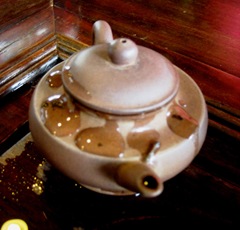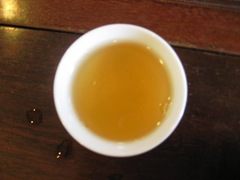Read this blog! The writer, though…eh, fairly hit or miss :P
Joking aside, after my last post on moldy tea, several folks wrote comments with more info/ideas on the tea. They were spot on about several points after reading just the little info that I had written and by looking at my pics. Impressive!
I brewed the tea last week and enjoyed it with a few tea friends. We used a small yixing pot that has been used only for dark teas (pu’er, Liu An…that type) for several years.
With old teas, I nearly always drink the rinse-brew also. With this particularly moldy one (and with a mold of unknown type or origin), we decided to rinse with boiling water, steep for about 20 seconds, toss the infusion, then brew. Immediately after pouring out the first drinkable infusion, we noticed that the color was very light, which is not typical of an old pu’er (especially for a supposed label cake).
The color of the brew was quite light, appearing more like a green pu’er cake’s brew or a light-moderately oxidized Dong Ding brewed in a gaiwan. There was also very little familiar fragrance. I’ve observed that old pu’ers tend to have an aroma that falls into one of 3 categories: camphor/woodsy; plum/apricot, and ginseng/herbal. Wait, there’s one more – crap (but like someone said, don’t knock the poo poo pu’er, it doesn’t always suck).
This brew smelled grassy. The taste was light and fleeting – it didn’t have the smooth and refined mouth-feel that I was expecting (ie. “silk water”) nor did it feel substantive. The taste reminded me a bit of the mixed, unidentifiable taste one would have by pouring hot water into an old, empty teapot that had been used to brew a certain type of tea for years. The pot retains traces of flavor and fragrance, but the brew itself would feel and taste confused and mixed. The energy of this tea also felt unstable. The taste and mouth-feel were more harsh than I was expecting. There was also an odd taste to the tea that reminded me of old teas that have been damaged by wet-storage. I’ve mentioned before that I’m not against wet-storing, in fact, I sometimes like the flavor and scent profile of wet-stored teas. However, the non-ideal storage conditions of this old tea have caused the flavors and aromas to feel as if they’ve been sealed away. I think that proper storage in a small, good-quality clay jar might help this tea release characteristics that are closer to its true flavor. There’s potential, but probably not for a mind-blowingly awesome brew.
I contacted my friend last weekend to figure out what tea he had given me. He was surprised that we could taste so many different kinds of flavors. He said I was right to guess that the tea was between 40-50 years old (he says it’s closer to 50) – which puts it out of range to compete in age with the fancy blue and red label pu’ers from the 40s and 50s (which corresponds to a comment that the tea just didn’t look quite as old as the famous label cakes). Another very astute reader pointed out that this tea, with its Golden Flowers, looked like Fu Zhuan tea – and she is absolutely right. The great article that she found on the Hojo Tea Site talks a lot more about Fu Tea. It is grown and processed differently than Pu’er and has different flavor and scent characteristics. Fu tea is also made in the Hunan area, whereas most Pu’er is made further south. My friend said that although yellow mold does grow on a variety of tea, it is especially prized for the development of Fu Zhuan tea. In fact, he said that this tea that he had given me needs to develop even more Gold Flower mold if it’s to improve in taste. Interesting indeed, and quite a pleasure to try something different and special.
Now back to oolongs. Drink good tea and enrich your life.










Got pictures of the wet leaves? Those tell a thousand words.
ReplyDeleteVery skeptical of 50 year old claim. Fu bricks don't look like that when they're 50. This looks like 10.
Sorry for the late reply MarshalN, totally missed this comment.
ReplyDeleteI had 2 servings of this tea and no pictures of the wet leaves. Yes, that wasn't very smart of me not to document the experience, but I am not very good with taking pics tea stuff in general (I'll make it a new year's resolution next year).
I have only had this tea one other time, so I cannot say how I feel about the age of it. It tastes more like a Liu An than a pu'er, but I haven't had enough old ones of any of these 3 to be able to accurately gauge age. I do believe that from the taste, smell and the way that the tea has degraded, that it looks a lot more like my 30-50 year old pu'er bricks/cakes/tuo than a 10 year, but....
Best,
Rich